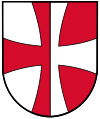St. Florian (Górna Austria)
 Klasztor St. Florian (2017) | |||
| |||
| Państwo | |||
|---|---|---|---|
| Kraj związkowy | |||
| Powiat | Linz-Land | ||
| Powierzchnia | 44,12 km² | ||
| Wysokość | 296 m n.p.m. | ||
| Populacja (1 stycznia 2015) • liczba ludności | 6014 | ||
| • gęstość | 136 os./km² | ||
| Numer kierunkowy | 07223, 07224 | ||
| Kod pocztowy | 4490 | ||
| Tablice rejestracyjne | LL | ||
| Strona internetowa | |||
St. Florian, Sankt Florian – gmina targowa w Austrii, w kraju związkowym Górna Austria, w powiecie Linz-Land. Liczy 6014 mieszkańców (1 stycznia 2015)[1].
W gminie znajduje się klasztor Sankt Florian.
Współpraca
Miejscowości partnerskie:
Przypisy
Linki zewnętrzne
Media użyte na tej stronie
Autor: Rosso Robot, Licencja: CC BY-SA 3.0
Location map of Upper Austria
Equirectangular projection. Geographic limits of the map:
- N: 48.78063° N
- S: 47.44388° N
- W: 12.73041° E
- E: 15.00183° E
Autor: Lencer, Licencja: CC BY-SA 3.0
Location map of Austria
Equirectangular projection, N/S stretching 150 %. Geographic limits of the map:
- N: 49.2° N
- S: 46.3° N
- W: 9.4° E
- E: 17.2° E
Autor: Bwag, Licencja: CC BY-SA 4.0
Südostansicht des Stiftes Sankt Florian in der oberösterreichischen Marktgemeinde St. Florian bei Linz.
Wann das Kloster gegründet wurde ist unbekannt, jedoch erste schriftliche Zeugnisse einer Klosteranlage gehen auf karolingische Zeit zurück (um 800 n. Chr.). Von 1668 bis in die Mitte des 18. Jahrhunderts erfolgte eine weitgehende Neuerrichtung des Stiftes unter Einbeziehung älterer Bausubstanz. Der Neubau zählt zu den glänzendsten Leistungen des österr. Barockbaues, der vorwiegend von dem Baumeister Carlo Antonio Carlone realisiert wurde.








